Resources
This list contains references to some of the best-known and geographically most widely-distributed resources on the topic of climate change and architectural resilience. It should be seen as a gateway to the subject.
You are required to select at least one resource from any of the categories (books, articles/lectures, and organizations) - or other pertinent and similar information sources - to support the research in your Proposal. (EDITED: 12, December 2018)
Books
Select one or more of these resources - or other pertinent and similar information sources - to substantiate the argument in your Proposal.
ArchitectsNewspaper: “AN rounds up our favorite climate change books of 2018”
(https://archpaper.com/2018/03/an-favorite-climate-change-books-2018/)
Thermal Delight in Architecture by Lisa Heschong
Design with Climate: Bioclimatic Approach to Architectural Regionalism by Victor Olgyay
Climate Considerations in Building and Urban Design by Baruch Givoni
Climate and Architecture by Torben Dahl
Adaptations of the Metropolitan Landscape in Delta Regions by Peter Bosselmann
(This is a very recent release and may not be readily available. Look on GOOGLE or other services for reviews and various ways through academic websites to read and download portions of this book.)
Articles/Lectures
Select one or more of these resources - or other pertinent and similar information sources - to substantiate the argument in your Proposal.
"Thes Rising-Star Designers are Making the World a Better Place"
(https://www.architecturaldigest.com/story/new-designers-doing-good)
"Flexcover - an Adaptive Building Envelope"
“Where Houses are Designed to Float.”
(http://www.bbc.com/travel/story/20150915-where-houses-are-designed-to-float)
“What Traditional Buildings Can Teach Architects about Sustainability.”
(http://edition.cnn.com/style/article/vernacular-architecture-sustainability/index.html)
The Philippines' New Clark City will be green and disaster-resilient - CNN Style
(https://edition.cnn.com/style/article/new-clark-city-philippines/index.html)
“Building Resilience: World Bank Group Experience in Climate and Disaster Resilient”
(http://www.worldbank.org/en/country/switzerland/publication/building-resilience-world-bank-group-experience-in-climate-and-dsaster-rsilient)
“Human Health in a Changing Climate”
(http://www.2degreesc.com/Files/CCandHealth.pdf)
“Miami’s Climate Ribbon merges art, science and architecture”
(https://www.ft.com/content/1f42088a-f13b-11e7-ac08-07c3086a2625)
“How to Fix Global Warming Smartly,” TED talk by Bjorn Lonborg
(http://www.youtube.com/watch?v=QsEt0-Di3AI&list=PL7lzpVoRhTAKKBjaBISVsbY3u5JpiAy3s)
“No Air Condtioner Needed: These Buildings Cool Themselves,” by Nicole Wetsman
(https://thebea.st/2u1zGdZ?source=email&via=mobile)
“Architecture for Humans Proposes Zero Emission Neighborhood to Address Climate Change” by Dima Stouhi
(https://www.archdaily.com/900643/architecture-for-humans-proposes-zero-emission-neighborhood-to-address-climate-change)
"Iceberg-inspired Greenland cultural center celebrates 20 years of resilience in the Artic,” by Lucy Wang
(https://inhabitat.com/iceberg-inspired-greenland-cultural-center-celebrates-20-years-of-resilience-in-the-arctic/)
“About the Bullitt Center, Seattle, U.S.A.”
(http://www.bullittcenter.org/)
"Climate change is transforming the way we build"
(https://www.raconteur.net/business-innovation/climate-change-is-transforming-the-way-we-build)
"How to Specify More Resilient Architecture"
(https://architizer.com/blog/practice/details/building-for-change/)
"North American houses turn to mush in a flood. What can we do about it?" By Lloyd Alter.
(https://www.treehugger.com/resilience/north-american-houses-turn-mush-flood-what-can-we-do-about-it.html)
Organizations
There are organizations across the globe whose focus of activity is the study of climate change and developing responses to these issues. Explore their websites to see what is actively being done to confront and adapt to climate change. “Adopt” one of these or similar organizations and relate their work to the subjects of your essay.
UNITED NATIONS DEVELOPMENT PROGRAMME: Climate Change Adaptation
(http://www.adaptation-undp.org/)
UNITED NATIONS UNIVERSITY: Institute for the Advanced Study of Sustainability, Tokyo
(https://ias.unu.edu/en/)
THE WORLD BANK: Resilient Cities Program
(http://www.worldbank.org/en/topic/urbandevelopment/brief/resilient-cities-program)
ASIAN INSTITUTE FOR ENERGY, ENVIRONMENT, AND SUSTAINABILITY
(http://aiees.snu.ac.kr/htmls/html/eng/main.html)
ECO-BUILD AFRICA: Promoting Sustainable Construction, Urban Development & Communities
(http://www.ecobuild-africa.com/home/?page_id=333)
URBAN LAND INSTITUTE: Urban Resilience Program
(https://americas.uli.org/research/centers-initiatives/urban-resilience-program/)
ROCKEFELLER FOUNDATION: 100 Resilient Cities
(http://www.100resilientcities.org/)
INTBAU: International Network for Traditional Building, Architecture & Urbanism
(http://www.intbau.org/)
|
|
|
 Blocked drains, Almora, India, 2017. Highlighting the problem of waste management and a potential threat in case of excessive rainfall. Photo credit: Neelakshi Joshi
 The Bullitt Center, Seattle, USA., 2013. The Bullitt Center is one of the greenest commercial buildings in the world. It is also the first urban infill projects to pursue and to receive a "Living Building" certification from the Interational Living Future Institute. The roof "prow" allows for an extended array of photovoltaic panels allowing the building to produce more electricity then it uses. Architect: Miller Hull. Photo credit: Brad Kahn ( http://www.bullittcenter.org/; https://en.wikipedia.org/wiki/Bullitt_Center)
 The Bullitt Center, Seattle, USA. Designed to have a 250-year lifespan, the building was also constucted without the use of common toxic building materials. It was the first mass timber building constructed in Seattle in 80 years. Photo credit: Brad Kahn (http://www.bullittcenter.org/; https://en.wikipedia.org/wiki/Bullitt_Center)
 The Bullitt Center, Seattle, USA. The rooftop solar panel array. The building also features an onsite rainwater-to-potable water system, an onsite composting toilet system, and 26 geothermal wells extending 120 m (400 feet) into he ground that help heat the building in the winter and cool it in summer. Photo credit: Brad Kahn (http://www.bullittcenter.org/; https://en.wikipedia.org/wiki/Bullitt_Center)
 Soso House, Leh, India. Designed and built by: Sonam Wangchuck and Neelakshi Joshi, 2016. Combining local earth and solar resources to address housing needs in a cold desert region. Photo credit: Neelakshi Joshi.
 Flux.Land is a geospatial risk and planning platform developed for Broward County, Florida by the University of Toronto's Daniels Faculty + MIT Urban Risk Lab. The Platform helps visualize various distinct elements of the built and natural environment, land use code and policy, in relation to climate risk and vulnerabilities. Image courtesy of Fadi Masoud. (https://www.urbanrisklab.org/fluxlad/)
 Flux.Land, Broward County, Florida, USA. "Our goal is to design and develop a web-based tool for Broward County to understand the potential adaptability of the urban fabric to manage the dynamic hydrological condition in the face of increased vulnerability due to climate change." Image courtesy of Fadi Masoud. (https://www.urbanrisklab.org/fluxlad/)
 Housing Project, Auroville, India. Building designed and built by: Auroville Earth Institute, 2012. A 17-unit housing project built using compressed earth blocks. An example of low cost and low carbon footprint housing. Photo credit: Neelakshi Joshi
 The Floating Village, Kompong Khleang, Cambodia. This village is a striking example of vernacular flood adaptation, and potentially a model for low-lying areas where climate change is resulting in increased flooding. Photo credit: Yohann Legrand. (http://www.bbc.com/travel/story/20150915-where-houses-are-designed-to-float)
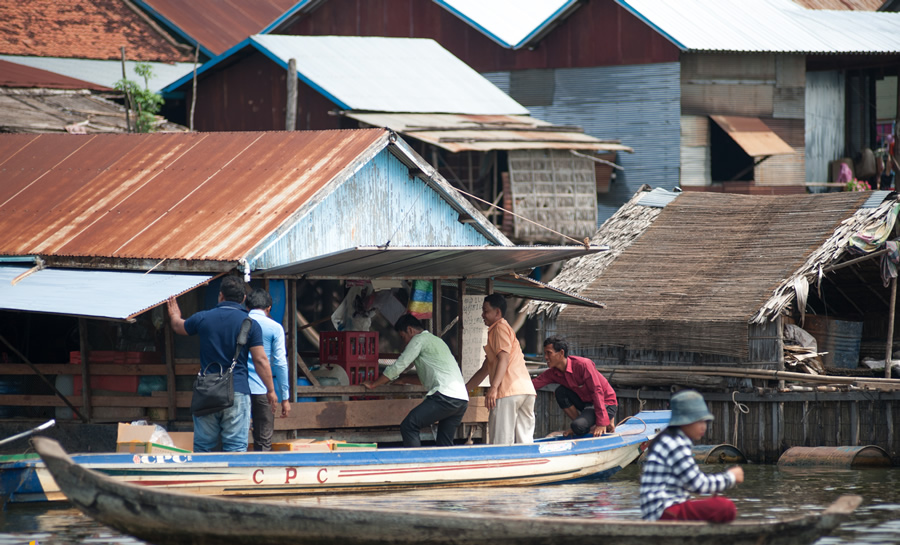 The Floating Village, Kompong Khleang, Cambodia. This fishing village sits on the Tonle Sap Lake that historically rises as much as five-fold during the rainy season. Houses are built both on stilts and as floating habitats. Photo credit: Yohann Legrand. (http://www.bbc.com/travel/story/20150915-where-houses-are-designed-to-float)
 Old City of Shibam, Yemen. This 16th century city of towers in the Wadi is an outstanding example of density and natural climate control. The city is on the United Nations World Heritage Danger List. Built of mud and located in a flood prone area, the city "remains at severe risk of major damage unless necessary preventive measures are taken...[involving] the conservation and use of Shibam oases, which are considered as the buffer zone of the property." Photo credit: Will De Freitas. (https://whc.unesco.org/en/list/192)
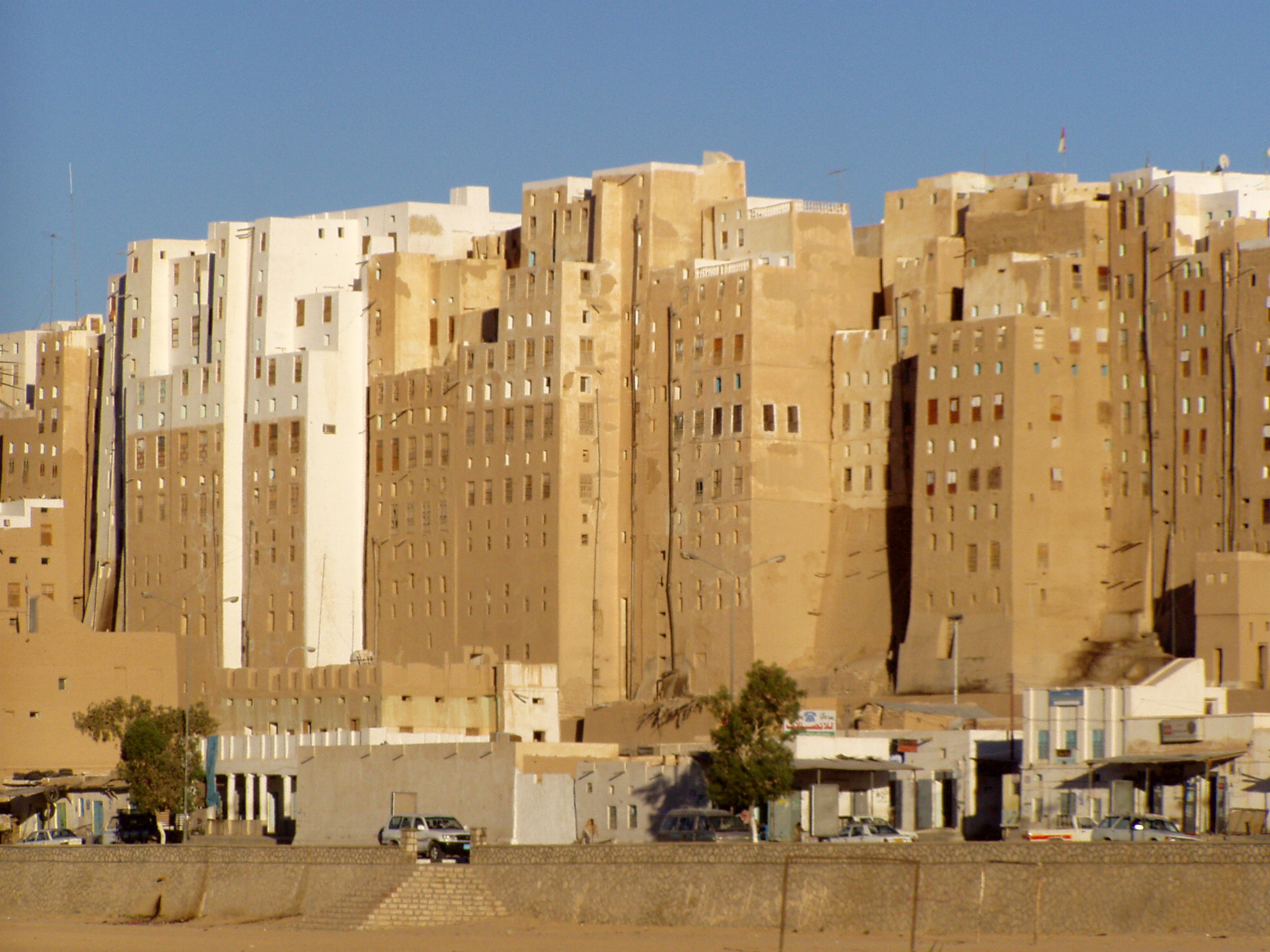 Old City of Shibam, Yemen. From the World Heritage listing: "Abandonment of the old agricultural flood management system in the wadi, the overloading of the traditional sanitary systems by the introduction of modern water supply combined with inadequate drainage, together with changes in the livestock management have all contributed to the decay of the city." Photo credit: Twiga_Swala
 Water Tank, Rweru Green Village, Rwanda, 2016. Rwanda's Green Fund invested in Rweru Green Village by providing water tanks, including this one which is connected to mains water to serve the community in times of drought. Photo Credit: Rwanda Green. (http://www.fonerwa.org/)
 Boston’s Resiliency Districts, Boston, Massachusetts, USA. The Norman B. Leventhal Center for Advanced Urbanism at MIT introduced a working concept of “resilient districts” for urban areas that are vulnerable to climate impacts. Resilient Districts include four central tenets 1) protecting critical infrastructure, 2) thickening regional soft systems, 3) transferring density to less vulnerable areas, and 4) encouraging landscape-based land uses in low laying areas. Image courtesy of Fadi Masoud. (http://lcau.mit.edu/)
 Shallow Dome Residence, Kalyani (near Kolkata), India. Designed by: Laurent Fournier. This is a unique example where a formal architectural project has incorporated incredible innovations taking place outside the professional world to help improve environmental performance of formal construction industry. "Shallow dome roofing" developed by informal masons from a village in northern India have made it possible to reduce use of steel and cement in building construction lowering its carbon footprint. Photo credit: Avikal Somvanshi
 Rainwater tank, Jalna, India. Designed by and built by: Neelakshi Joshi, 2018. Preparing for water variability by enabling houses to be water sufficient. Photo credit: Neelakshi Joshi.
 Ladder House, Auroville, India. Designed and built by: Avikal Somvanshi and Manu Gopalan, 2012. A fast-track eco-friendly dis-mountable housing prototype that can be used to provide semi-temporary housing post-natural disaster in tropical regions. Built by unskilled volunteers using bamboo ladders, coconut-coir ropes and recycled tetrapak sheets on a retired tracker-trolley the structure has been use since. Photo credit: Avikal Somvanshi.
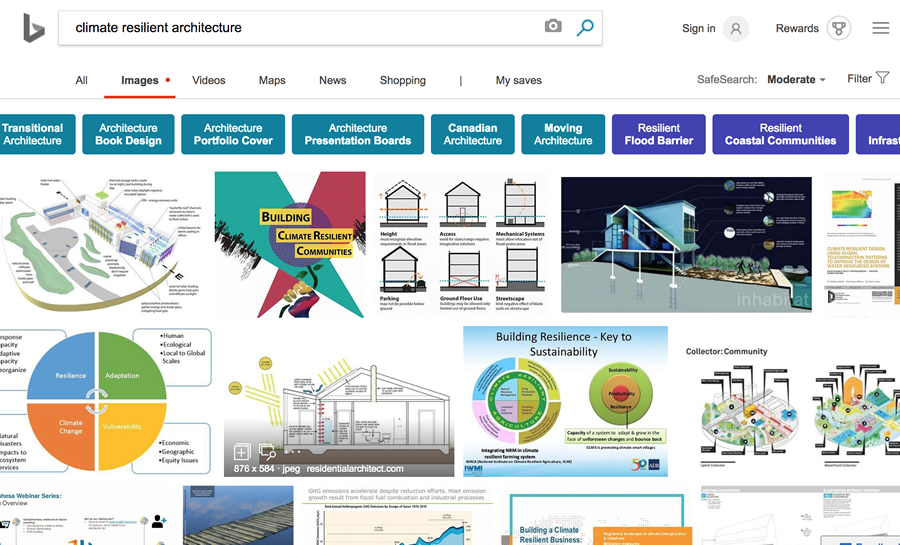 Bing Image Search: "Climate resilient architecture"
 Hunnarshala Foundation Office, Bhuj, Gujarat, India. Designed and built by: Sandeep Virmani and Kiran Vaghela. The campus is living laboratory of innovation and experiments with traditional building techniques and modern lifestyle requirements. The campus is splattered with examples how age-old construction practices can be brought to speed and help address the resource and resilience issues especially in rural areas. Photo credit: Avikal Somvanshi.
 Understanding community perceptions and preparations for a variable climate, 2017. Fieldwork conducted in emergent urban settlements of the Himalayas. Photo credit: Neelakshi Joshi.
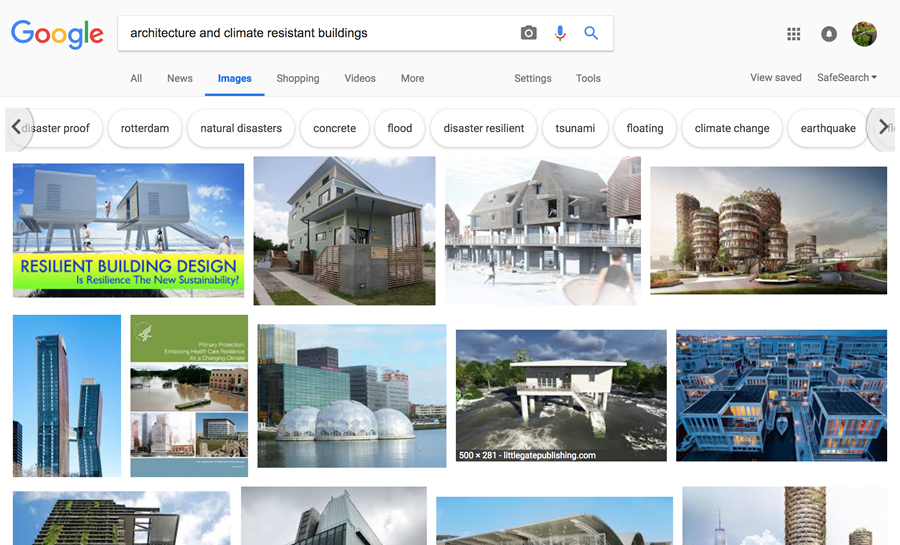 Google Image Search: "Architecture and climate resistant buildings"
1.jpg) Condominium 1 at the Sea Ranch, California, USA. Designed by: Donlyn Lyndon,. A wind-protected courtyard. Photo credit: Donlyn Lyndon.
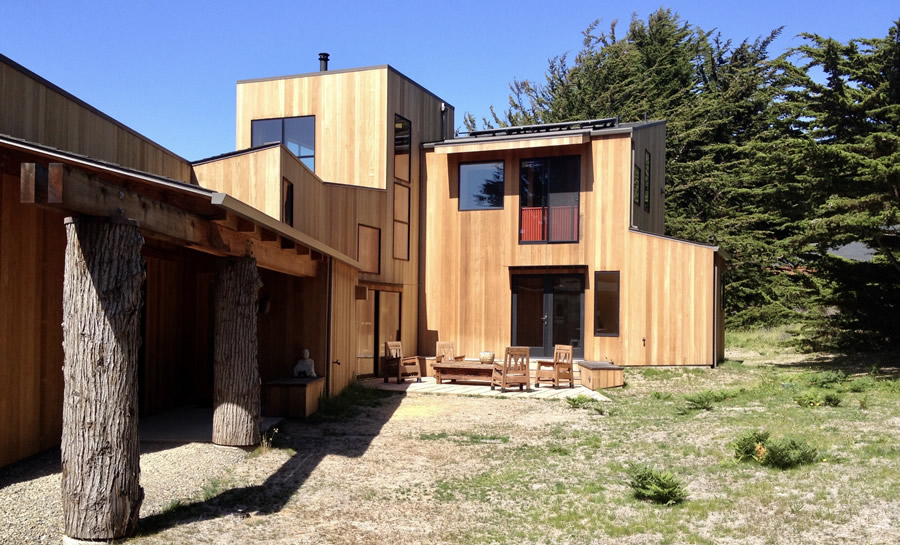 The Bowsprit House at the Sea Ranch, CA, USA. Designed by: Donlyn Lyndon FAIA, with Tomas Frank and Associates, Architects. Wind-sheltered courtyard with tower to gather light into the rooms of the house from all directions, and shading for south facing windows in the living spaces. Photo credit: Donlyn Lyndon.
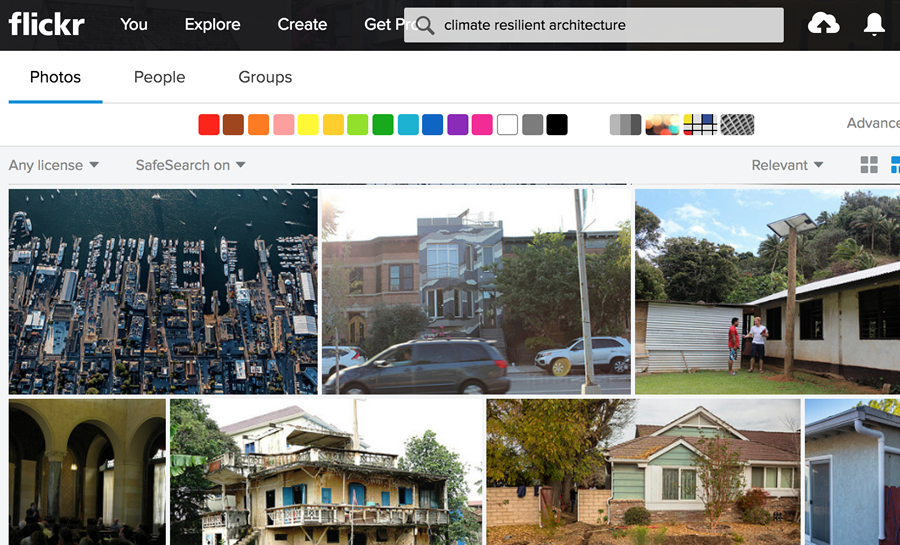 Flickr Image Search: "Climate resilient architecture"
|
|






















1.jpg)

